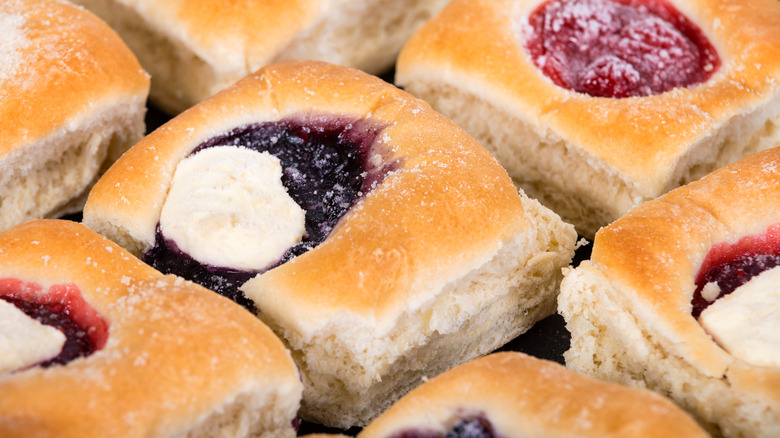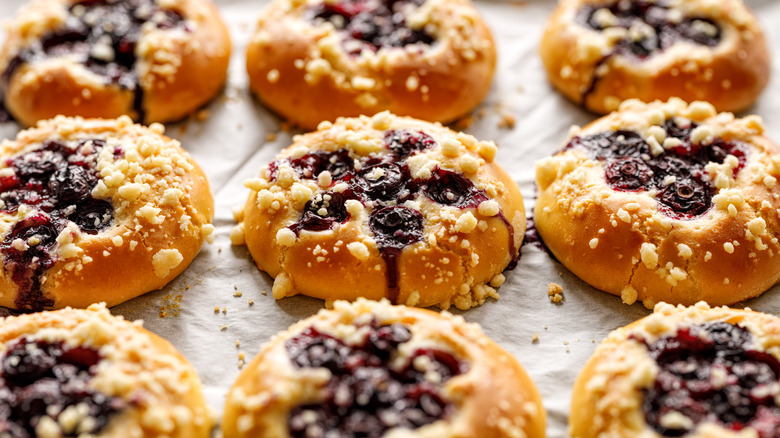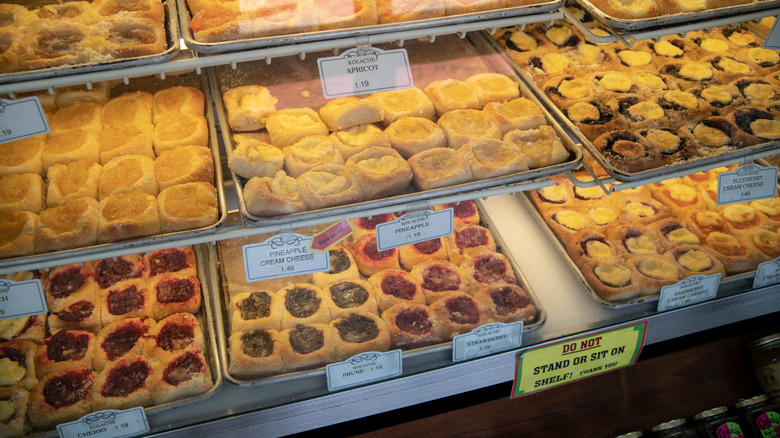Why Kolaches Are So Popular In Texas
Even if you've only driven through or flown over Texas, you're probably aware that the state is known for certain trademark foods like barbecue, Tex-Mex, and kolaches (pronounced koh-LAH-cheez). Similar to a donut, a kolache is a sweet, square-shaped doughy pastry that's usually filled with some type of fruit jelly, but newer varieties can include savory fillings like sausage. These treats are made with a delectable, airy yeast dough, The East Texas Weekend explains.
Texas natives will tell you these tasty Czech pastries are a staple in the state and often make appearances at office parties, holiday gatherings, and countless other social events. But what's less known about kolaches is the reason they're so popular in The Lone Star State. How did a Czech pastry (that many people fail to pronounce correctly on the first try) even end up in the second-largest state in the U.S., and how did they get to be all the rage in Texas?
Czech immigrants introduced kolaches to Texas in the 1800s
It all started in the late 1800s when immigrants from the Czech Republic established communities in Central Texas, according to NPR. A standard Czech Texas farm back then probably included a primary cash crop typical of the region, but in addition to adapting to their new environment, the Czechs also brought items from their homeland, including kolaches, says Texas Highways.
The original versions of these tasty pastries consisted of poppy seed, apricot, or farmer's cheese, NPR explains. Today, you can find them filled with blueberry, strawberry, apple, and other sweet fillings. Sandy Ferrell, owner of Czech Please, a microbakery in East Mountain, Texas, describes them to East Texas Weekend as "healthy donuts," since they're baked rather than fried.
Texas Highways claims the 19th-century wave of Czech immigrants in Texas consisted of about 700 people, but by the early 1910s, more than 15,000 foreign-born Czechs resided in the state, per the Texas State Historical Association. In an effort to honor their heritage, they held festivals, according to Texas Real Food – one of which was the Kolache Festival in the city of Caldwell, which is still celebrated today. The popularity of the sweet treat eventually led people to sell them at church markets. But a man named Wendel Montgomery took things a step further, says NPR, when he opened the first Texas kolache bakery, The Village Bakery.
The first Texas kolache bakery opened in 1952
Montgomery's daughter, Mimi, told NPR that her father opened his kolache bakery in 1952 in West, Texas, on a dare. Although many other Czech immigrants in Texas were making their own kolaches (in their homes), calling into question whether anyone would go out and buy the traditional treat from someone else, Montgomery had an advantage that home bakers didn't: His shop gave travelers who weren't familiar with the pastry a public place to buy them.
Not long after the bakery opened, Montgomery introduced a savory version of the kolache after being inspired by a hot dog, per Texas Real Food. He called it the klobasniki, which means "sausage" in Czech. Unlike kolaches, the first klobasnikis were filled with jalapeno sausage and cheese, or just sausage. Today, you can also find them filled with eggs, brisket, and other delights that make these pastries almost a full meal in themselves.
Over the next few decades, more kolache bakeries started popping up in Texas, including Kolache Factory, the world's largest seller of kolaches, according to the Houston Chronicle. Kolaches will likely forever be a Texas staple, thanks to the Czech immigrants who introduced them in the 1800s. And thanks to Wendel Montgomery, you can also enjoy the savory meat-filled "kolache spinoff," klobasnikis, at various bakeries all over the state.


